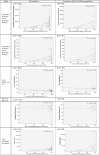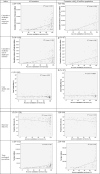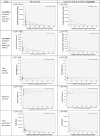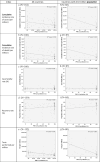Correlation between environmental factors and COVID-19 indices: a global level ecological study
- PMID: 34651278
- PMCID: PMC8516493
- DOI: 10.1007/s11356-021-16876-x
Correlation between environmental factors and COVID-19 indices: a global level ecological study
Abstract
This global level ecological study aimed to investigate the correlation between environmental factors and the COVID-19 indices. This survey is an ecological study, so all studied variables are aggregate variables. To collect the variables in the study, a data set was provided, which includes the information of each country based on the cumulative deaths, case fatality rate, recovery rate, and the number of performed COVID-19 tests. Scatter plots of environmental factors for the studied countries were drawn based on cumulative incidence rate of cases, cumulative incidence rate of death, tests, recovery rate, and case fatality rate of COVID-19. Furthermore, Spearman correlation coefficient was also used to verify the correlation between environmental factors and indicators related to COVID-19. The results of this ecological study showed that among all countries surveyed, Montenegro (60,310.56 per million) and Luxembourg (54,807.89 per million) had the highest cumulative incidence rates of COVID-19 cases, when Tanzania (8.42 per million) and Vietnam (13.78 per million) had the lowest cumulative incidence rates of COVID-19. In addition, in this study, it was shown that the cumulative incidence rate of cases, the cumulative incidence rate of deaths, and performed COVID-19 tests had significant direct correlations with the access to drinking water and the access to sanitation services (p < 0.001). The findings of the present study showed an inverse correlation between the mortality rate due to unhealthy water consumption, poor health status, and a positive correlation between access to drinking water and health services with the cumulative incidence and mortality rates of COVID-19. The differences between our findings and many other studies could be due to the ecological nature of the study. Nevertheless, our findings will help health policymakers to develop timely strategies to reduce the mortality and incidence rate of COVID-19.
Keywords: COVID-19; Coronavirus; Ecologic study; Environmental factors.
© 2021. The Author(s), under exclusive licence to Springer-Verlag GmbH Germany, part of Springer Nature.
Conflict of interest statement
The authors declare no competing interests.
Figures




Similar articles
-
Correlation between human development index and its components with COVID-19 indices: a global level ecologic study.BMC Public Health. 2022 Aug 15;22(1):1549. doi: 10.1186/s12889-022-13698-5. BMC Public Health. 2022. PMID: 35971079 Free PMC article.
-
Correlation Between Diabetes and COVID-19 Indices: A Global Level Ecological Study.SAGE Open Nurs. 2023 Apr 3;9:23779608231165485. doi: 10.1177/23779608231165485. eCollection 2023 Jan-Dec. SAGE Open Nurs. 2023. PMID: 37032958 Free PMC article.
-
Factors associated with the spatial heterogeneity of the first wave of COVID-19 in France: a nationwide geo-epidemiological study.Lancet Public Health. 2021 Apr;6(4):e222-e231. doi: 10.1016/S2468-2667(21)00006-2. Epub 2021 Feb 6. Lancet Public Health. 2021. PMID: 33556327 Free PMC article.
-
Increase in COVID-19 cases and case-fatality and case-recovery rates in Europe: A cross-temporal meta-analysis.J Med Virol. 2020 Sep;92(9):1511-1517. doi: 10.1002/jmv.26035. Epub 2020 Jun 2. J Med Virol. 2020. PMID: 32437052 Free PMC article. Review.
-
Infection fatality rate of COVID-19 inferred from seroprevalence data.Bull World Health Organ. 2021 Jan 1;99(1):19-33F. doi: 10.2471/BLT.20.265892. Epub 2020 Oct 14. Bull World Health Organ. 2021. PMID: 33716331 Free PMC article. Review.
Cited by
-
Correlation between human development index and its components with COVID-19 indices: a global level ecologic study.BMC Public Health. 2022 Aug 15;22(1):1549. doi: 10.1186/s12889-022-13698-5. BMC Public Health. 2022. PMID: 35971079 Free PMC article.
-
Epidemiological characteristics and outcomes of COVID-19 in asymptomatic versus symptomatic patients.J Prev Med Hyg. 2022 Jan 31;62(4):E854-E858. doi: 10.15167/2421-4248/jpmh2021.62.4.2254. eCollection 2021 Dec. J Prev Med Hyg. 2022. PMID: 35603235 Free PMC article.
-
Self-management of patients with chronic diseases during COVID19: a narrative review.J Prev Med Hyg. 2022 Jan 31;62(4):E814-E821. doi: 10.15167/2421-4248/jpmh2021.62.4.2132. eCollection 2021 Dec. J Prev Med Hyg. 2022. PMID: 35603256 Free PMC article. Review.
-
Correlation Between Diabetes and COVID-19 Indices: A Global Level Ecological Study.SAGE Open Nurs. 2023 Apr 3;9:23779608231165485. doi: 10.1177/23779608231165485. eCollection 2023 Jan-Dec. SAGE Open Nurs. 2023. PMID: 37032958 Free PMC article.
References
-
- Babu SR, Rao NN, Kumar SV, Paul S, Pani SK. Plausible role of environmental factors on COVID-19 transmission in the Megacity Delhi. India: Aerosol and Air Quality Research; 2020. p. 20.
-
- Bourgonje AR, Abdulle AE, Timens W, Hillebrands JL, Navis GJ, Gordijn SJ, Bolling MC, Dijkstra G, Voors AA, Osterhaus AD. Angiotensin-converting enzyme 2 (ACE2), SARS-CoV-2 and the pathophysiology of coronavirus disease 2019 (COVID-19) J Pathol. 2020;251(3):228–248. doi: 10.1002/path.5471. - DOI - PMC - PubMed
MeSH terms
Substances
Grants and funding
LinkOut - more resources
Full Text Sources
Medical

